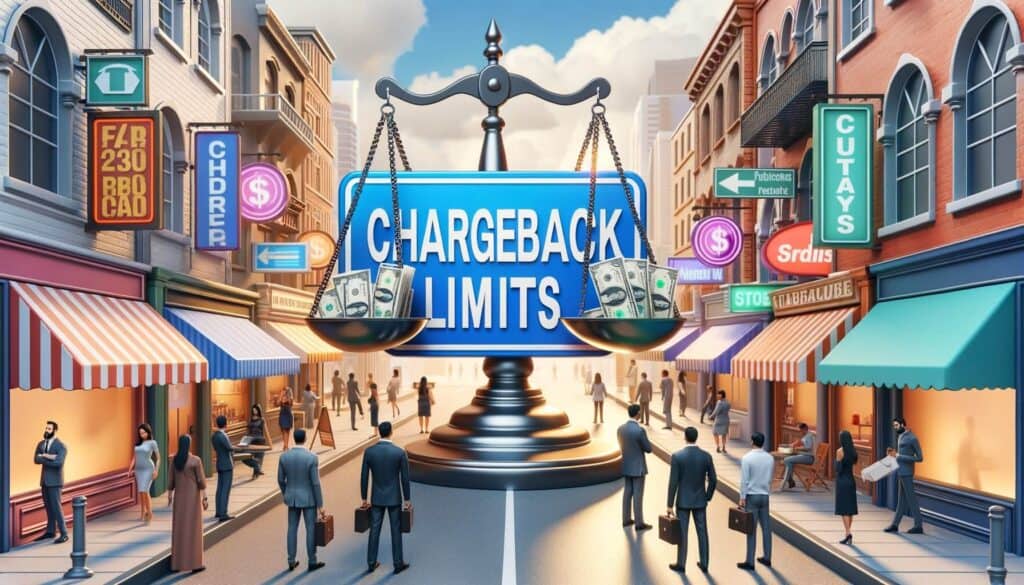
By Carol Peters March 10, 2025
In the ever-evolving world of commerce, chargebacks have become an integral part of the payment process. Chargebacks occur when a customer disputes a transaction and requests a refund from their bank or credit card issuer. While chargebacks are designed to protect consumers from fraudulent or unauthorized transactions, they can pose significant challenges for merchants. One crucial aspect of chargebacks that merchants need to understand is chargeback limits.
Chargeback limits refer to the maximum number of chargebacks a merchant can receive within a specific timeframe before facing severe consequences, such as fines, penalties, or even the termination of their merchant account. These limits are set by payment processors, card networks, and acquiring banks to ensure that merchants maintain a satisfactory level of customer satisfaction and minimize the risk of fraud.
The Importance of Chargeback Limits for Merchants

Chargeback limits play a vital role in protecting both merchants and consumers. For merchants, chargebacks can have a detrimental impact on their business operations. Excessive chargebacks not only result in financial losses but also damage a merchant’s reputation and credibility. High chargeback ratios can lead to increased processing fees, higher reserve requirements, and even the loss of the ability to accept credit card payments altogether.
On the other hand, chargeback limits also benefit consumers by ensuring that merchants provide quality products and services. By setting limits, payment processors and card networks encourage merchants to maintain high standards and resolve customer disputes promptly. This helps to build trust between merchants and consumers, fostering a healthy and sustainable business environment.
Factors Influencing Chargeback Limits in 2025

Several factors influence chargeback limits in 2025. These factors are constantly evolving as technology advances and consumer behavior changes. Understanding these factors is crucial for merchants to effectively manage their chargeback limits and mitigate potential risks.
1. Industry Type: Different industries have varying levels of risk associated with chargebacks. High-risk industries, such as travel, online gaming, and adult entertainment, typically have higher chargeback limits due to the nature of their business. Low-risk industries, such as grocery stores or clothing retailers, may have lower chargeback limits.
2. Historical Chargeback Ratio: Merchants with a history of high chargeback ratios are more likely to have lower chargeback limits. Payment processors and card networks closely monitor a merchant’s chargeback ratio, which is the percentage of chargebacks compared to total transactions. Merchants with a consistently high chargeback ratio are seen as a higher risk and may face stricter limits.
3. Transaction Volume: Merchants with a higher volume of transactions may have higher chargeback limits. This is because a larger number of transactions can naturally result in a higher number of chargebacks. However, merchants must still maintain a reasonable chargeback ratio to avoid penalties.
4. Customer Satisfaction: Merchants that prioritize customer satisfaction and have a track record of resolving customer disputes efficiently are more likely to have higher chargeback limits. Payment processors and card networks value merchants who prioritize customer service and take proactive measures to prevent chargebacks.
How Chargeback Limits are Calculated in 2025

The calculation of chargeback limits in 2025 involves a combination of historical data, industry benchmarks, and risk assessment algorithms. Payment processors and card networks use sophisticated systems to analyze a merchant’s transaction history, chargeback ratios, and industry-specific data to determine appropriate chargeback limits.
1. Historical Data Analysis: Payment processors and card networks analyze a merchant’s historical chargeback data to identify trends and patterns. They consider factors such as the number of chargebacks, the reasons for chargebacks, and the resolution rate. This analysis helps them assess the merchant’s risk profile and set appropriate chargeback limits.
2. Industry Benchmarks: Payment processors and card networks compare a merchant’s chargeback ratios to industry benchmarks to determine if they are within acceptable limits. These benchmarks provide a reference point for evaluating a merchant’s performance and identifying potential areas for improvement.
3. Risk Assessment Algorithms: Advanced risk assessment algorithms are used to evaluate a merchant’s risk level based on various factors, including transaction volume, average ticket size, and customer dispute history. These algorithms consider both historical data and real-time information to calculate chargeback limits that reflect the merchant’s risk profile accurately.
Strategies for Managing Chargeback Limits Effectively

Merchants can adopt several strategies to manage their chargeback limits effectively and minimize the risk of exceeding them. By implementing these strategies, merchants can maintain a healthy chargeback ratio and ensure the longevity of their business.
1. Improve Customer Service: Providing exceptional customer service is crucial for reducing the likelihood of chargebacks. Merchants should prioritize prompt and effective communication with customers, address their concerns promptly, and offer fair and reasonable resolutions to disputes. By focusing on customer satisfaction, merchants can prevent chargebacks before they occur.
2. Implement Fraud Detection and Prevention Measures: Fraudulent transactions can lead to chargebacks, so it is essential for merchants to implement robust fraud detection and prevention measures. This can include using advanced fraud detection tools, verifying customer information, and implementing secure payment gateways. By proactively identifying and preventing fraudulent transactions, merchants can reduce chargebacks and maintain a healthy chargeback ratio.
3. Optimize Product Descriptions and Images: Clear and accurate product descriptions and images can help manage customer expectations and reduce the likelihood of chargebacks due to product dissatisfaction. Merchants should provide detailed information about their products, including dimensions, materials, and any potential limitations. High-quality images that accurately represent the product can also help prevent misunderstandings and customer dissatisfaction.
4. Offer Easy Refund and Return Policies: Transparent and customer-friendly refund and return policies can help prevent chargebacks by providing customers with an alternative to disputing a transaction. Merchants should clearly communicate their refund and return policies, making it easy for customers to request refunds or returns. By offering hassle-free refund and return processes, merchants can resolve customer disputes amicably and avoid chargebacks.
The Role of Technology in Mitigating Chargebacks
Technology plays a crucial role in mitigating chargebacks and helping merchants manage their chargeback limits effectively. Advancements in fraud detection, data analytics, and payment processing have enabled merchants to identify and prevent chargebacks more efficiently.
1. Advanced Fraud Detection Tools: Merchants can leverage advanced fraud detection tools that use machine learning algorithms to analyze transaction data and identify potential fraudulent activity. These tools can detect patterns and anomalies in real-time, allowing merchants to take immediate action to prevent chargebacks.
2. Data Analytics: Data analytics tools enable merchants to gain insights into their transaction data, chargeback ratios, and customer behavior. By analyzing this data, merchants can identify trends, patterns, and potential areas for improvement. This information can help merchants make data-driven decisions to reduce chargebacks and improve customer satisfaction.
3. Secure Payment Gateways: Secure payment gateways provide an additional layer of protection against fraudulent transactions. These gateways use encryption and tokenization technologies to secure sensitive customer information, reducing the risk of data breaches and unauthorized transactions. By implementing secure payment gateways, merchants can instill confidence in their customers and minimize the risk of chargebacks.
Best Practices for Merchants to Avoid Chargebacks
To avoid chargebacks and maintain healthy chargeback ratios, merchants should follow best practices that prioritize customer satisfaction and fraud prevention. By implementing these practices, merchants can minimize the risk of chargebacks and maintain a positive relationship with their customers.
1. Clear Communication: Merchants should ensure clear and transparent communication with customers throughout the purchasing process. This includes providing accurate product descriptions, shipping information, and order confirmations. Clear communication helps manage customer expectations and reduces the likelihood of misunderstandings that can lead to chargebacks.
2. Timely Order Fulfillment: Merchants should strive to fulfill orders promptly and provide customers with timely updates on the status of their orders. Delays in order fulfillment can lead to customer dissatisfaction and increase the risk of chargebacks. By prioritizing efficient order processing and shipping, merchants can minimize the risk of chargebacks due to delayed or undelivered orders.
3. Robust Dispute Resolution Process: Merchants should have a well-defined and efficient dispute resolution process in place to address customer concerns and resolve disputes promptly. This includes providing multiple channels for customers to reach out, such as email, phone, or live chat. By demonstrating a commitment to resolving customer issues, merchants can prevent chargebacks and maintain customer loyalty.
4. Ongoing Monitoring and Analysis: Merchants should continuously monitor their chargeback ratios, transaction data, and customer feedback to identify potential issues and areas for improvement. By proactively analyzing this information, merchants can take corrective actions to prevent chargebacks and enhance their overall business operations.
Common FAQs about Chargeback Limits in 2025
Q1. What happens if a merchant exceeds their chargeback limits?
Answer: If a merchant exceeds their chargeback limits, they may face severe consequences, including fines, penalties, or the termination of their merchant account. Excessive chargebacks indicate poor customer service or fraudulent activity, which can damage a merchant’s reputation and credibility.
Q2. Can merchants appeal their chargeback limits?
Answer: Merchants can appeal their chargeback limits if they believe they have been unfairly set. However, the success of an appeal depends on providing compelling evidence to support their case, such as improved customer service practices, fraud prevention measures, or a significant reduction in chargeback ratios.
Q3. How can merchants track their chargeback ratios?
Answer: Merchants can track their chargeback ratios through their payment processor or merchant account provider. These platforms typically provide detailed reports and analytics that allow merchants to monitor their chargeback ratios and identify any potential issues.
Q4. Are chargeback limits the same for all payment processors and card networks?
Answer: Chargeback limits can vary between payment processors and card networks. Each entity sets its own limits based on their risk assessment algorithms, industry benchmarks, and historical data. Merchants should consult with their payment processor or acquiring bank to understand their specific chargeback limits.
Conclusion
In the rapidly evolving landscape of commerce, chargeback limits play a crucial role in protecting both merchants and consumers. Understanding chargeback limits in 2025 is essential for merchants to effectively manage their chargeback ratios, maintain customer satisfaction, and minimize the risk of financial losses and reputational damage.
By implementing strategies for managing chargeback limits, leveraging technology to mitigate chargebacks, and following best practices, merchants can navigate the complex world of chargebacks and build a successful and sustainable business.
